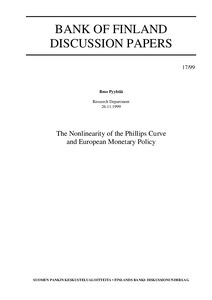The nonlinearity of the Phillips curve and European monetary policy
Pyyhtiä, Ilmo (26.11.1999)
Numero
17/1999Julkaisija
Suomen Pankki
1999
Julkaisun pysyvä osoite on
https://urn.fi/URN:NBN:fi:bof-20140807496Tiivistelmä
This paper deals with the question of whether the euro area Phillips curve is nonlinear.There has recently been a great deal of discussion and studies concerning the same question in the US context.The data set includes most of the euro area countries, namely Austria, Germany, Finland, France, Italy, the Netherlands and Spain.Estimation is made both with pooled data and with country-specific models.The results give a clear indication of nonlinearity of the Phillips curve in many euro countries.The curve is asymmetric in the sense that, with a positive output gap (actual output is greater than potential output), its impact on inflation is positive, but, with a negative output gap, the deflationary impact is very small and not significant as a rule. The Phillips curve has been especially asymmetric in Germany, Finland, Italy, the Netherlands and Spain.An important result of the study is the strong negative influence of inflation uncertainty on GDP in the euro countries during the estimation period, 1976-1997.This effect was very strong in pooled data but also at country level.This result is new in the sense that a Lucas-type supply function and especially nonlinear versions of it have not been estimated very often.Another interesting result is that Phillips curves can be estimated with good success using OECD Secretariat forecast data for inflation expectations.A very important result for monetary policy are the large differences between countries as regards the slope and shape of the Phillips curve.The policy implication of nonlinearity is clear.The costs of unduly expansive monetary policy could be high in the euro area in the medium term.Nonlinearity also means that inflation pressure in the euro area is dependent not only on the average demand situation but also on how economic activity is distributed across the region. Key words: Phillips curve, nonlinearity, monetary policy, uncertainty, euro area country differences
